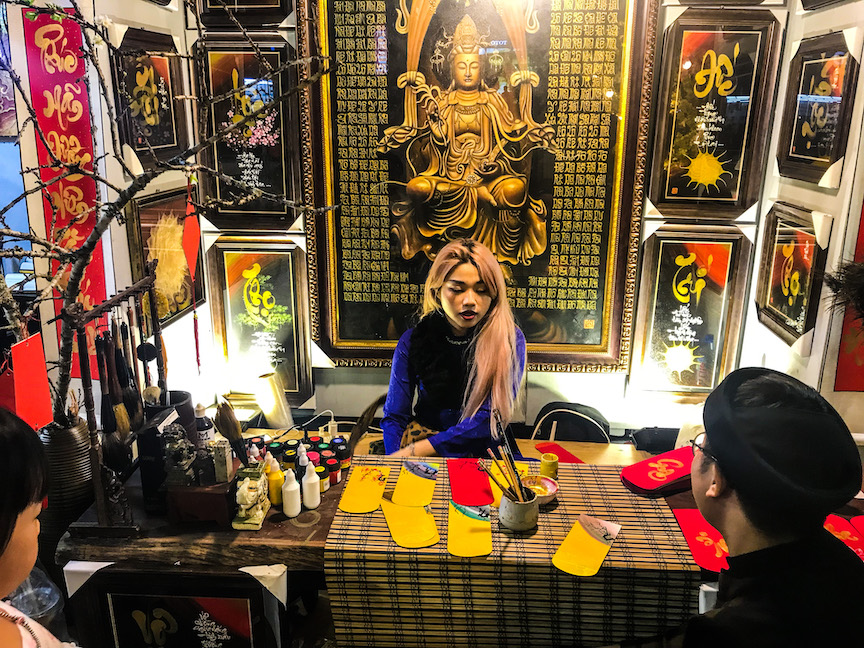
A spiritual calligrapher considers the appropriate fortune to paint for patrons during pre-Tết observances. The holiday week is a time for Vietnamese families to start life anew, and messages such as hers may be important elements. Photo by John Gottberg Anderson
By John Gottberg Anderson
I celebrated my first Tết holiday, as Vietnamese call the lunar new year, at the start of 2020. I arrived in Vietnam three months earlier, partially at the behest of my friend Kurt Bennett, whose Vietnamese in-laws had dubbed him Mỹ Mập (“Fat American”). His wife’s extended family lived in a fishing village in Vinh Long province in the heart of the Mekong Delta region, and I was delighted when they invited me to share in their celebration.
My first lesson was to learn how to say “Happy New Year” in Vietnamese: Chúc mừng năm mới! Over the next four days, I followed my friends in making offerings of food and incense at family graves and shrines. We prayed and had our fortunes told at the local Buddhist pagoda. On the morning of the new year, we gave “lucky money” in red envelopes to children.
Haute Cuisine
Feasts highlighting Delta specialties were especially popular. After initial apprehension, I found myself eating bullfrogs, field mice and freshwater eels, straight from the rice padis. Birds in highly contested cockfights who had the misfortune of losing were plucked, chopped and fried and became part of the feast as well.
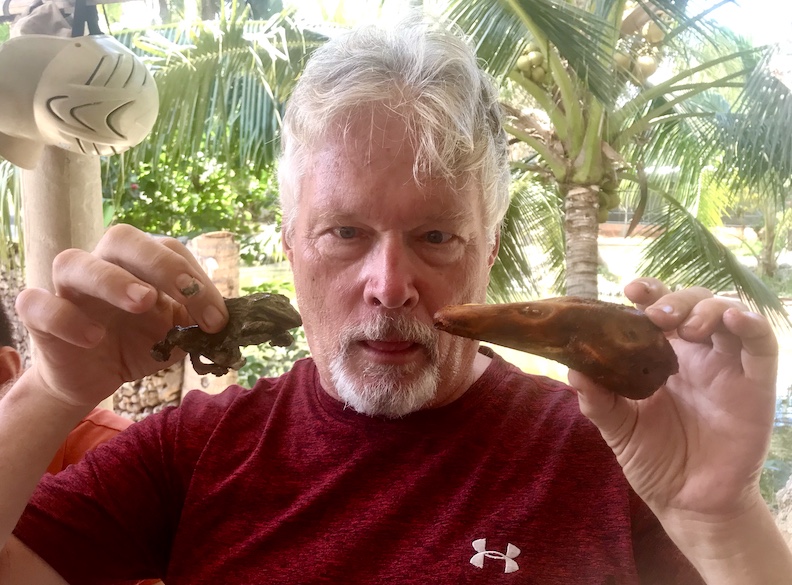
Frog or duck? Writer John Gottberg Anderson hesitates only momentarily before embracing all the entrées offered at his first Tét feast. He remembers eating more squid and baby octopus than field mice and freshwater eels. But after numerous cups of rice wine he doesn’t remember much.
Alcohol was not in short supply. Beer by the case was supplemented with bottles of potent homemade rice “wine,” made with fermented fruit and sometimes including a marinated snake. The beverage tasted like lighter fluid. But so much of it was consumed during drinking games that had the snake suddenly sprang back to life, I doubt anyone would have noticed.
Year of the Cat
The shadow of the Covid pandemic dampened the spirit of Tết in Vietnam during the ensuing two years. But life in this Southeast Asian nation is quickly returning to normal. The Year of the Tiger may have come in like a lamb, but it’s going out like a predator as the tourist economy roars back to life. The Year of the Cat (unlike neighboring China, it is not the Year of the Rabbit) is already sharpening its claws for a full-on assault upon 2023. Urban revitalization projects, including flashy hotels and a modern subway system, are back on track in Ho Chi Minh City. A new suspension bridge across the Saigon River links apartment mega-complexes to the city’s core.
But Tết is not an ideal time for visitors to stop in HCMC (the former Saigon), even during a boom. Many tourists find it a three-day-and-out city at any time. At Tết, they may prefer rural resort destinations. At holiday time, Saigon and Hanoi, the national capital, offer less opportunity to engage Vietnamese, who get out of town for a week or sometimes two.
All government businesses, including popular museums, are closed during the Tết holiday. Many restaurants will stay open but many more will close, as top chefs and their staff take a break. Shops will also close. Without personal friends in the cities, there’s not a lot to do except to watch fireworks bursting over the Saigon River or Hanoi’s Hoan Kiem Lake, admire decorations and perhaps drop into a temple or two.
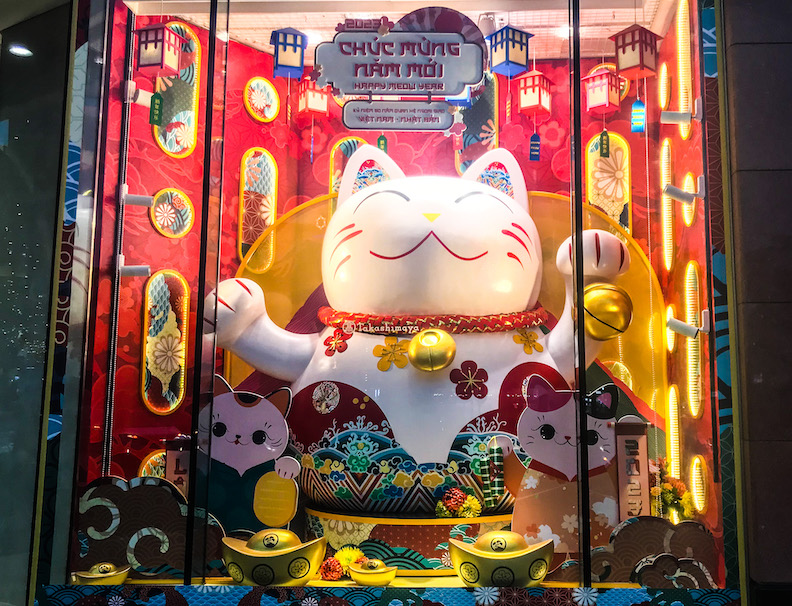
A Japanese-looking cat smiles from the window of the Takashimaya department store in downtown Ho Chi Minh City. In 2023, Vietnamese are preparing to welcome the Year of the Cat — as opposed to the Year of the Rabbit that will be celebrated in China. The words Chúc mừng năm mới mean Happy New Year! Photo by John Gottberg Anderson
Hometown Dreams
Stymied by travel restrictions in 2021 and 2022, citizens plan to head out of the cities in droves by the eve of the lunar new year — the first new moon of the annum — which falls this year on Sunday, January 22. Tết is the only full week vacation that most Vietnamese get in any calendar year. It’s equivalent to the Christmas-New Year’s week in Western culture, with Thanksgiving thrown in for good measure.
Where do urban Vietnamese go? They head home, or to their parent’s or grandparents’ homes. A common introductory question among new friends, after name and age, is: “What is your hometown?” Hanoi, in the north, is the administrative, cultural and educational hub of Vietnam, but Ho Chi Minh City is the country’s commercial and economic center.
For the past quarter-century, young adults have swarmed to HCMC to make money at a rate not considered possible elsewhere in Vietnam. Along with the increased population have come growth issues such as traffic jams and environmental pollution. But during Tết, millennials leave it all behind for a week or more. The family reunion I experienced in Vinh Long is repeated countless times in rural areas and country towns throughout the nation.
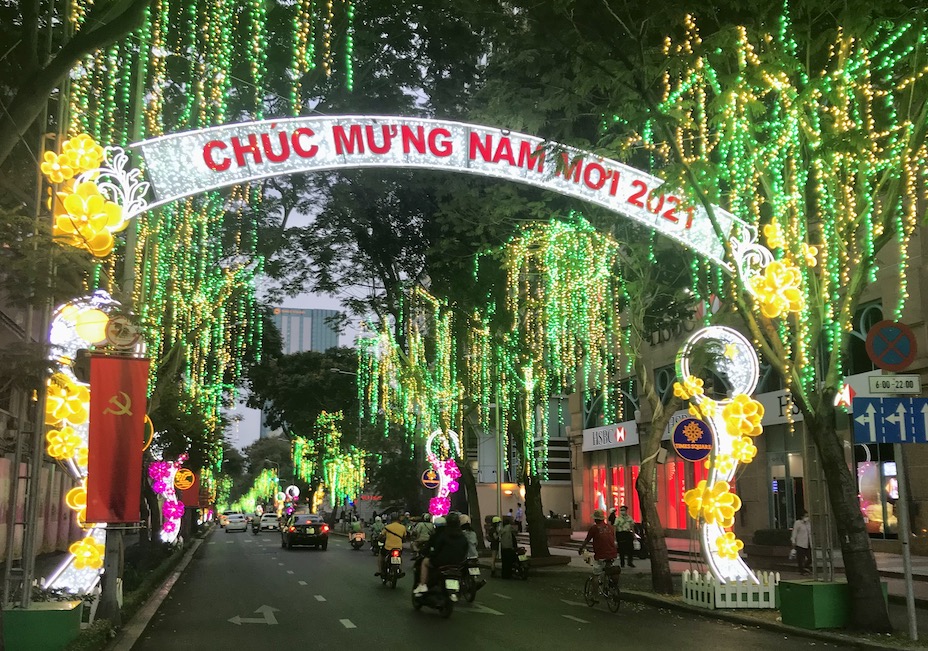
A colorful gateway on southbound Dong Khoi, a major shopping thoroughfare in downtown Ho Chi Minh City, welcomed the new year in 2021. The city goes all out in its decorations, even though many citizens take a vacation week elsewhere in Vietnam. Photo by John Gottberg Anderson
Apricot and Peach Blossoms
This is not to say there isn’t a celebration in the big cities. In Saigon, the broad pedestrian promenade at the heart of the city, Nguyen Hue (loosely pronounced “Win Way”), is converted to “Flower Street,” its Rose Parade-worthy creations lighting up the city center nightly throughout the jubilee calendar. Street vendors barbecue skewered pork and squid that become part of delicious and inexpensive meals. There will be music and dancing until 10 at night.
Festivities begin a couple of weeks early on the blocks surrounding the Cultural House for Youth near Turtle Lake just north of the Nôtre-Dame Cathedral in District 1. Here, the floral symbols of the holiday — especially bright yellow hoa mai (apricot) blossoms believed to attract good luck and wealth — frame streets lined with calligraphers, artists and food purveyors.
Both venues are selfie heavens for TikTok and Instagram lovers. Beautiful women in traditional ao dai, flashing sunny smiles and youthful optimism, pose demurely beside potted shrubs and freshly inked affirmations.
In Hanoi, with its four-season climate, Tết ushers in the spring season. Rather than delicate hoa mai, its hardier blooms are pink peach blossoms, peaceful and elegant, and auspicious kumquat trees, covered with small orange fruits representing happiness and prosperity. The flowers are especially in evidence around Hoan Kim Lake and Ba Dinh Square, near the mausoleum of founding father Ho Chi Minh.
New Year Traditions
Preparations for Tết start before the holiday itself. Maintaining a clean household is very important in Vietnamese culture, yet sweeping during Tết is considered unlucky, as one doesn’t want to sweep away the good luck that the new year brings. Every house does a thorough cleaning in the days and weeks leading up to Tết. It’s imperative also to begin the new year with a clean financial slate, so families make a special effort to pay off lingering debts. And most Vietnamese look forward to buying new clothes for their wardrobe.
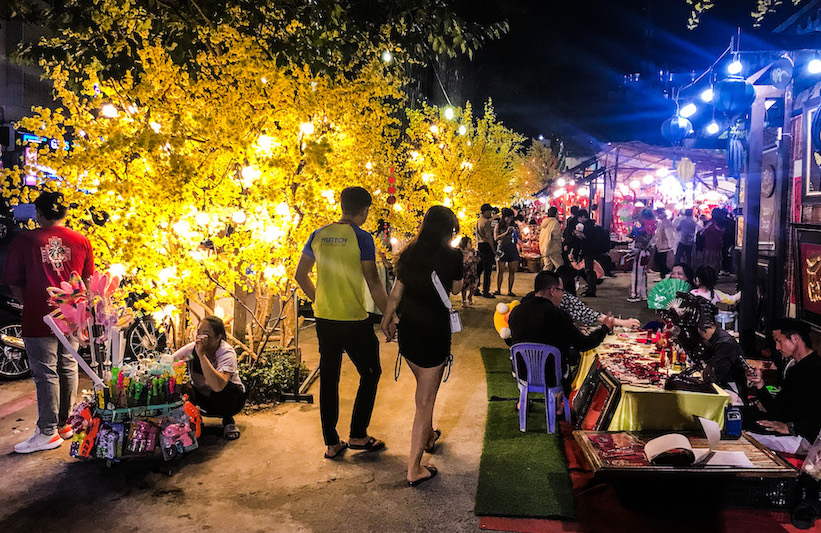
A couple stroll past artists, calligraphers and hoa mai trees at a Tết holiday fair in Saigon’s District 1. The annual event, in the streets surrounding the Cultural House for Youth, precedes the flamboyant Flower Street celebration by about two weeks. Photo by John Gottberg Anderson.
Almost before they know it, it’s New Year’s Eve, the day before the new moon (in 2023, January 21). A first priority is always to pray at the family altar and to worship ancestors at their graves, cleaning up the burial grounds as a sign of respect. And then the feasting begins. Womenfolk show off their culinary skills, cooking special foods such as bánh tét, bánh chưng and other savory rice cakes. There are bánh dày sausage rolls, wrapped in banana leaves, and thịt kho hột vịt, caramelized pork and eggs. Dried bamboo and pork spring-roll soups are served with traditional sticky rice.
The practice of being the first to enter a house or business in the new year is so important, it has its own name: xông nhà. That single action can determine a household’s fortune for the next 12 months, as the home is seen to take on the character of its first new arrival. On New Year’s Day, one must never enter a door unless first invited. If a home or business owner is unsure of the morality and stature of his anticipated first guest, he might even step out a few minutes before midnight and immediately return after 12. An esteemed (and wealthy) business associate might well be preferred over a ne’er-do-well son sneaking in after a night of drinking with friends.
A Vietnamese friend of mine, Thanh Thao, told me about another superstition that she learned from her grandparents — that the first animal you hear after the stroke of midnight will also direct fortunes in the new year. The purring of a cat, for instance, would speak to a year of calm and relaxation, whereas a yipping dog could suggest turmoil. And what, I wondered, about the crowing of a rooster? Or the buzzing of a mosquito? She laughed.
Lucky Money
Children know what “Happy New Year!” means: Lucky money! The kids slip into their best new outfits and approach elders with the greeting: “Chúc mừng năm mới!” In response, they are gifted a bright red envelope with crisp bills inside. Southern Vietnamese call it li xì (“lucky”), northerners mừng tuổi (“happy age”).
Much as in the West, the new year is a measuring stick for changes, plans and progress. There are no deliberate “resolutions” here, but especially on the lunar year’s first day, Vietnamese pay special attention to every action they take, every word they say. The next 364 days depend upon it. An unkind word to a spouse, certainly, might really get the year off on the wrong foot.
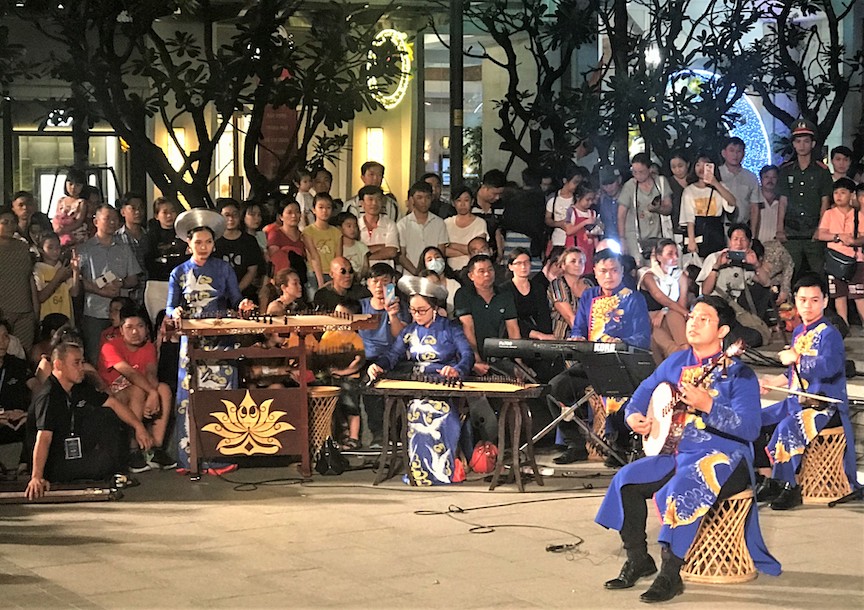
Classical musicians perform an outdoor Tết concert at the head of Nguyen Hue. The broad pedestrian promenade is converted to “Flower Street” each year during the holiday’s peak time, which in 2023 is considered to be January 19 to 26. Photo by John Gottberg Anderson
Celebrations may last a full week. The second and third days of Tết are spent visiting friends, relatives, teachers, pagodas and temples. At the latter, they pray to Buddhist, Taoist and Confucianist deities, make donations and have their fortunes told. Some prosperous families may hire múa lân dancers — half lion, half dragon — to perform at their homes to disperse evil spirits, or sponsor parades, where the cacophony of firecrackers, gongs, bells and drums is certain to scare away malevolent spirits.
Blast from the Past
Literally, the word Tết means “festival.” (The formal name of the lunar new year observance is Tết Nguyên Đán: “Festival of the First Day of the Year.”) The celebration was no doubt inherited in the distant past from China, which used the lunar cycles to mark the beginning of spring and a new rice-planting season.
Zodiacal calendars are similar, but with slight variations: Vietnam, for example, replaces the traditional Ox and Rabbit with the Water Buffalo and Cat. (Ironically, the Cat follows its larger cousin, the Tiger.) The reason is unclear, but some scholars say it has to do with the separate pronunciation of ancient ideograms.
Many older Americans who lived through the era of the Vietnam War (called the American War by the Hanoi government) continue to equate Tết with the Tết Offensive of 1968 when the North Vietnamese army broke an informal holiday truce with the South to launch surprise attacks upon dozens of unsuspecting locations. Young Vietnamese don’t remember what happened 55 years ago. Their parents, or most certainly their grandparents, do.
More than 7,700 civilians from Hué to Saigon died in the attacks on five major cities and 36 provincial capitals. According to government figures, over 18,000 were wounded and nearly 700,000 lost their homes.
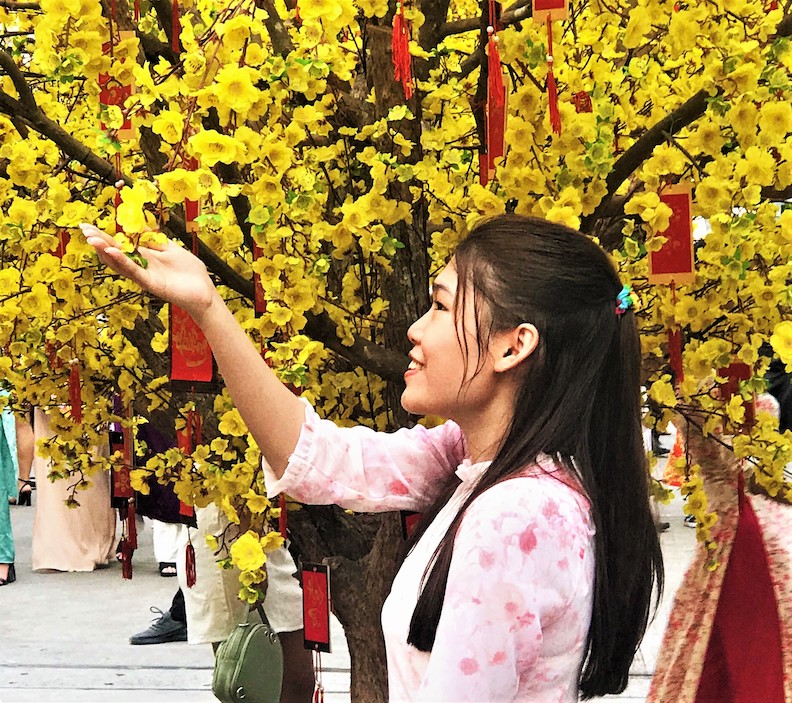
A young Saigon woman reaches for the crêpe-like yellow blossoms of the hoa mai, or apricot, a floral symbol of the Tết holiday considered to attract good luck and wealth. In Hanoi, by contrast, pink peach blooms are preferred. Photo by John Gottberg Anderson
I won’t be returning to Vinh Long this year. I now have friends in many other parts of Vietnam. They have asked me to join them, to experience the holiday at Buon Ma Thuot in the Central Highlands, in Phan Thiet on the beaches of the South China Sea, or among the historic ruins near Hué on the Central Coast. Wherever I choose to celebrate, I know that I’ll find the warmth and hospitality of people whose culture is anchored in ancient tradition.![]()
American writer John Gottberg Anderson lives in Vietnam. His past articles for EWNS focused on the city of Saigon and the elegantly feminine áo dài.


1 Comment